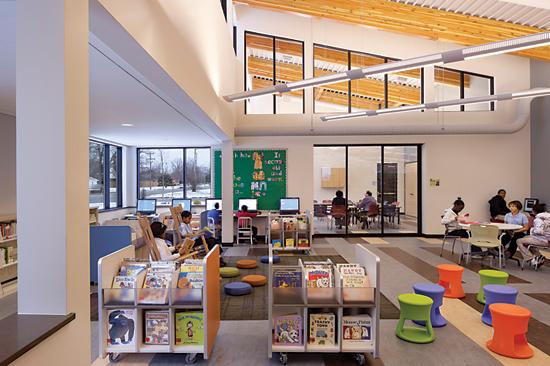Designer Forum - January 2012
By Steven Rothe
Libraries today need to offer flexible spaces that can accommodate changing information and community needs for decades into the future, while simultaneously making a connection to their populations. The Louisville Free Public Library (LFPL) set out to respond to these needs by building its Newburg Branch Library, the first ever in its community—a hub for technology and a gathering spot for the neighborhood.
The first new library to be built in Louisville, Kentucky since 1996, the Newburg Library offers a current mix of study, technology, and communal gathering spaces that serve a constant rotation of users from children to teens to adults. Supporting a suburban community of roughly 8,000 households, including three elementary schools and two middle schools nearby, the library is heavily used.
To address current and future flexibility needs, the 8,300 square-foot library offers a large, open public space. Composed of a neutral off-white shell filled with windows for natural light, the perimeter of the space places the focus on the activity within. This activity is grounded in the flooring pattern that connects the multiple open spaces of the library from the adults’ and teens’ areas on one side to the children’s area and multipurpose room on the other.
The design team deliberately kept the number of flooring types to a minimum and carefully integrated their allocation with the library’s overall layout in order to both minimize the number of flooring transitions and simplify the space. This layout allows the adults’ and teens’ areas to benefit from the acoustical qualities of carpet, while the children’s area and multipurpose room benefit from the cleaning properties of linoleum. With competing demands for open space, the common linoleum floor surface allows each area to expand and contract as needed. Anchored by a loosely laid bound Bentley Prince Street broadloom area rug accompanied by flexible furniture, the children’s area can be cleared out for other program uses for teens or adults when larger events or meetings take place.
The transition between the two halves of the flooring pattern, composed of carpet tile and linoleum, is centered below and mimics the exposed structure of the building’s asymmetrical butterfly roof line. Based on a common 50 centimeter unit dimension, the carpet tile and linoleum bands work together while still retaining their own sense of identity. The carpet tile pattern is a subtle interpretation of the branch library’s geographical coordinates expressed as a bar code, creating a gentle rhythm that establishes a sense of place for the adults’ and teens’ areas, while balancing the more dominant linoleum pattern. This linoleum pattern, with its starts and stops of coffee brown and barley cream bands on a steel blue-grey background, was inspired by the concept of digital encoding. It is also an abstract woven expression of the community design process used to “weave together threads of need, use, and value, making this library part of the community fabric right from the start,” as LFPL Director Craig Buthod states in the April 2010 issue of American Libraries.
With longevity in mind, the design team selected a solution-dyed carpet tile made of type 6,6 nylon. Carpet tile addresses both maintenance and acoustical concerns, and the solution-dyed type 6,6 nylon fiber ensures that it will perform well for a long time. InterfaceFlor’s What Goes Around met this need, as well as the clean-lined aesthetic goals for the project.
Choosing between soft and hard surface flooring is often an issue in children’s areas of libraries. At Newburg, cleaning was the driver and 2.5 millimeter linoleum was selected. The coffee brown and barley cream linoleum bands and steel blue-grey background were found in Forbo’s Real offering. We chose sheet goods over linoleum tile despite Forbo’s 50 centimeter Dual option; the welded linoleum surface provides an impervious floor that is easy to clean and warm to the touch. Sheet goods also help reinforce the linear qualities of the linoleum bands.
In response to both cost constraints and maintenance needs, rubber base was specified throughout the library except for the restrooms. To further simplify the space, 4” high coved base was used at both carpeted and hard surface areas, eliminating any inline transitions between straight and coved base styles. One-eighth inch thick coil stock was also specified in order to increase durability and eliminate as many joints as possible.
This Newburg library is The City of Louisville’s first LEED (Leadership in Energy and Environmental Design) Silver-certified building. From a sustainability perspective, it features flooring carefully selected for long-term durability and environmental impact. The carpet tile has 67% recycled content (26% post-consumer) with its GlasBac RE backing. A 100% bio-based product, linoleum contains 33% rapidly renewable materials, such as linseed oil, pine rosin and jute, as well as other natural components likes wood flour and limestone. Linoleum has 46.5% post-industrial recycled content and is self-healing and naturally bactericidal.
To balance the bolder flooring pattern, sophisticated neutral colors were selected. The darker brown and charcoal carpet tile colors possess a certain vitality, as well as help to mask any soiling issues. The coffee brown and barley cream bands animate the children’s area and multipurpose room when contrasted with the steel blue-grey field color. To further animate the children’s and teens’ areas, brightly colored stools, book bins, and upholstery fabrics were selected.
The interior of the Newburg Library reflects the clean lines of the architecture and the library’s modern vision. A key element to the interior, the flooring pattern helps to weave together the multiple open spaces needed for flexibility and serves to make a distinct connection with the community. Having won the New Landmark Award from the Louisville Historical League, an award that honors new buildings that fit well into their contextual environment, the Newburg Branch Library is a new cornerstone for its community.
Copyright 2012 Floor Focus
